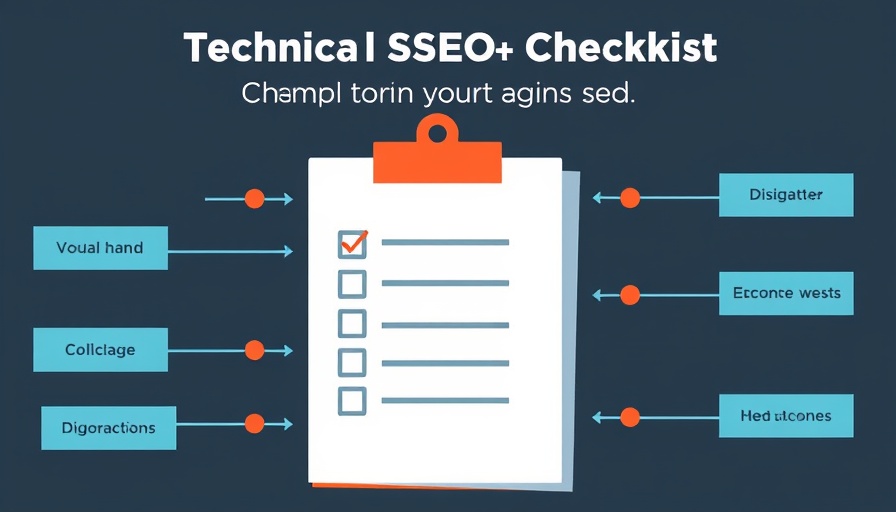
Understanding Market Analysis: The Bedrock of Business Strategy
Market analysis is more than just a buzzword; it is a crucial element in determining the viability of your business offerings and long-term success. This process involves comprehensively studying your market dynamics, assessing your competition, and identifying consumer trends that can significantly influence your initiatives. Whether you're considering launching a new product or seeking to expand your reach, understanding how to execute a market analysis can guide your decisions towards sustainable growth.
Why Market Analysis Matters: Navigating Today’s Business Landscape
For small and medium-sized businesses (SMBs), the pressure to remain competitive in a rapidly evolving marketplace is immense. With the advent of digital technology and global connectivity, consumer needs are constantly shifting. Through rigorous market analysis, SMBs can identify gaps and opportunities tailored to their target audience. This insight not only helps in validation efforts before launching a new product but also informs marketing strategies that resonate with potential customers.
Steps to Conduct an Effective Market Analysis
Properly conducting a market analysis requires a structured approach, typically involving several key steps:
- Define the Purpose: Begin with clarity. Are you validating a new product idea, assessing investment opportunities, or seeking avenues for expansion? Having a clear objective will provide focus throughout the analysis.
- Analyze Market Size: Understanding the total addressable market (TAM), serviceable addressable market (SAM), and serviceable obtainable market (SOM) will help you gauge the full potential of your market. Tools like Semrush can assist in extracting these insights by comparing your business against competitors.
- Study the Competition: A competitive landscape analysis is essential. Identify who your competitors are, what they offer, and their unique selling propositions. This will not only highlight your own strengths but also identify threats within your market.
- Identify Your Target Audience: Knowing who your customers are and what drives their purchasing behaviors is crucial. Effective segmentation will allow you to tailor your marketing strategies.
- Analyze Industry Trends: Being aware of broader trends and forecasts in your industry, such as technological advancements or shifting consumer preferences, can inform your strategic decisions.
- Conduct a SWOT Analysis: Strengths, Weaknesses, Opportunities, and Threats (SWOT) will give you a comprehensive view of your business’s internal capabilities and external market conditions.
- Summarize Data and Offer Recommendations: Compile insights and data points identified in previous steps to draw conclusions about your market strategy moving forward.
A Case Study: Implementing Market Analysis for Growth
Consider a fitness software company aiming to cater to independent gyms. By defining their purpose and market size accurately, they discovered an underserved segment of urban wellness studios. Using market analysis tools, they identified a unique demographic of gym owners who valued efficiency and customer engagement tools. By crafting their marketing message around these insights, the company not only validated their product but also established a loyal customer base.
Future Insights: Shaping Your Marketing Strategy
The business landscape continually morphs, significantly influenced by technological advancements and consumer expectations. For SMBs, developing a robust market analysis protocol can be greatly advantageous. As the focus shifts towards personalized marketing strategies powered by AI and data analytics, businesses that invest resources into understanding their market trends, consumer needs, and competition will likely thrive in tomorrow's world.
Common Misconceptions in Market Analysis
Many believe that market analysis is a one-time task, yet the reality is different. The marketplace is dynamic, requiring ongoing analysis to stay relevant. Additionally, there’s often a misconception that extensive data is needed for effective analysis. In truth, focused data relevant to your business context can yield significant insights.
The Importance of Execution: Putting Insights into Practice
Once the market analysis is complete, translating insights into actionable steps is paramount. Businesses should develop a strategic action plan that clearly outlines steps to capitalize on identified opportunities and address potential threats.
In conclusion, the process of market analysis, while intricate, is fundamentally beneficial for SMBs looking to refine their offerings and establish stronger market positions. Understanding your environment leads to informed decision-making and long-term success. As you dive into the process, remember that the insights drawn can shape both your immediate marketing strategies and your broader business trajectory.
For those eager to implement meaningful change, harness the power of a detailed market analysis today. Consider how these insights could redefine your market strategies and propel you toward your business goals.
 Add Row
Add Row  Add
Add 




Write A Comment